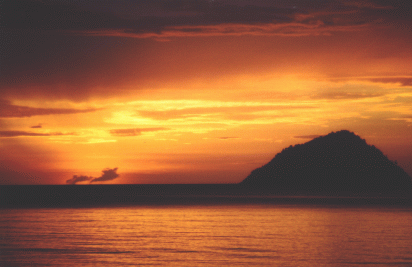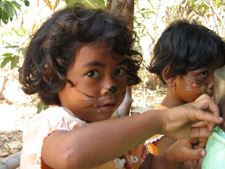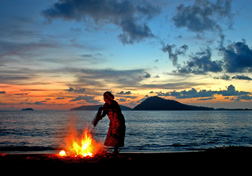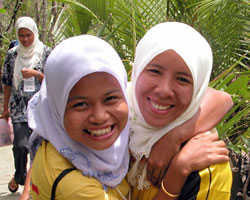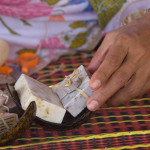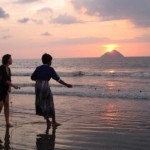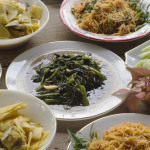“Village by the Sea”
Ban Talae Nok is apt naming for the village. Ban mean village, Talae means sea and Nok is used to describe something at a distance; translating to ”Faraway Village of the Sea” which is a perfect description for this quaint community perched on the Andaman Sea.
The traditional Ban Talae Nok way of life is characterized by fishing and farming, both crops and animals such as buffalo, cows, goats, chickens and ducks. In the past villagers grew rice to exchange with their neighbors. Traditionally when the men come back from fishing, they stay at home repairing traps and nets in preparation for the next trip. The women helped by making wooden fish traps, baskets and mattresses for their families, using the Pandan (a tree similar to palm, with a strong fibrous leaf) which grows abundantly around the village. They also make the traditional thatch roof (made from ‘bai-jak’ palm) and shrimp paste which is used in most cooking dishes. Some women also go fishing near the shore or in the mangrove forest, to supplement the family’s income.
The beautiful beach of Ban Talae Nok has a distinctive golden tint, due to the presence of tin. The ten kilometer stretch, in part owned by the National Park, is backed by Casuarinas pine trees, mangrove forest and small lagoons.
![]() The village itself is set up for homestays that can accommodate single travelers and groups, with many cultural and ecotourism activities available around the area.
The village itself is set up for homestays that can accommodate single travelers and groups, with many cultural and ecotourism activities available around the area.
History
The village was founded over 100 years ago and predates other villages on the peninsula, the village population is 99% Muslim and an Islamic way of life is followed. Electricity arrived 14 years ago and there is one road in and out of the village. Originally, the pursuit of tin and its high value brought people to the site. Tin foraging was a profitable endeavor; by scouring the beaches, people could find up to five kilograms of tin a day, which was worth 120 baht per kilo.
Eventually the tin supply dried up and the villagers took to the sea. This income could be supplemented by making coal from the mangroves, and by baking wood in huge domed ovens. For environmental reasons, in recent years this practice has been banned as commercial activity but is still permitted for personal use.
Before the road into the village was built, access was by boat or a long trek through the jungle. Electricity came to the village in 1990, and the first westerners came to the village ten years later.
Tsunami Story
Ban Talae Nok village is abundant with the bounty from the sea, the land, and local wisdom. We are proud to be born here and be a part of the village. -Nui, Ban Talae Nok villager
Ban Talae Nok lost 46 villagers in the tsunami, 16 of whom were children. Before the tsunami, the village was divided into two: an upper and lower part. The lower village, located along the beach, provided easy access for the fishermen to go out to sea. The tsunami destroyed all 20 houses in the lower village. A new tsunami village was built up near the upper village.
Environment
Ban Talae Nok’s 10-kilometre stretch of stunning beachfront has a distinctive golden tint, endowed by the presence of tin. Part owned by the National Park, it is bounded by casuarina pine trees, mangrove forests, and small lagoons that provide habitat and breeding grounds for an array of sea life.
When the sun sets in a red glow many villagers gather on the beach with their lawa (shrimp nets) to catch the keruy (small shrimp), believing the arresting red hue signifies the arrival of shrimp.
Thai families are lovely and the ones we visited did everything they could to make our stays enjoyable. I was amazed by how much can be communicated through mime. I felt I really bonded with my home-stay families despite the language barrier. -Doug International Volunteer Society University of Birmingham
The sea and islands dotted off the coastline from Ban Talae Nok are an important part of village identity. Each island has been named and is treasured for its unique features. These are:
- Bat Island (Koh Kang Kao) — with a big cave home to many bats.
- Japanese Island (Koh Yee Puun) — once inhabited by Japanese people pearl farming
- Kum Nui Island (Koh Kum Nui) — a smaller island with an abundance of shells.
- Kum Yai Island (Koh Kum Yai) — with spectacular white, sloping beach with clear blue waters, great for snorkeling.
- Lan Island (Koh Lan) — a barren, rocky island with a cave.
- Buffalo Island (Koh Kao Kwaay) — there is a subsidiary office of the National Park on this island. It is one of the most beautiful islands in the area. It has a curved beach and coral reef, and is a popular fishing site.
Religion in Ban Talae Nok
Ban Talae Nok is a traditional Muslim village. Islam shapes their daily lives and throughout the year there are several important ceremonies, presided over by the Imam (Muslim High Priest). Some of these important cultural traditions are as follows:
- The beginning of Ramadan, when the villagers prepare for the Ramadan ceremony.
- Ramadan: lasting 30 days during which villagers must not eat or drink between sunrise and sunset.
- Eid-al-Fitr, big celebrations that mark the end of Ramadan.
- The Sunut cultural ceremony, which takes place when a boy is nine years old and a girl is fourteen years old.
- Nika (Marriage ceremony), both the man and woman consent to marriage.
- Funeral ceremony at the Koobo (graveyard).
- Lamaad (praying) where Muslim people pray five times a day.
Awards
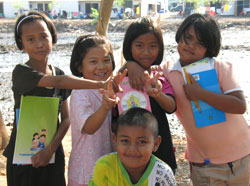 The Eco Tourism club of Ban Talae Nok won the silver Kinnaree Award for “Outstanding Performance: Best Eco Tourism Attraction” in the 2008 Thailand Tourism Awards, presented by the Tourism Authority of Thailand (TAT). A 20-member selection committee from TAT visited the village in August and assessed it on such criteria as environmental stewardship, community participation, sufficiency-economy philosophy, good governance, and responsibility to society.
The Eco Tourism club of Ban Talae Nok won the silver Kinnaree Award for “Outstanding Performance: Best Eco Tourism Attraction” in the 2008 Thailand Tourism Awards, presented by the Tourism Authority of Thailand (TAT). A 20-member selection committee from TAT visited the village in August and assessed it on such criteria as environmental stewardship, community participation, sufficiency-economy philosophy, good governance, and responsibility to society.
A Ban Talae Nok Village Tour can offer the following activities:
Soap making
The Ban Talae Nok soap cooperative was established after the tsunami by a group of housewives and young women. The group makes beautifully handicraft soap using the finest natural ingredients. Everyone is invited to watch an informative demonstration given by the soap ladies. After the demonstration, you can then try your hand at making the soaps, with the expert guidance of the soap group ladies.
Batik
Batik is a technique of hand-dyeing fabrics by using designs drawn in wax. You can create your own design or have your host draw one for you, then color in the beautiful designs, and keep your creation as a souvenir.
Mangrove Tour
Explore the mangrove forest in a long-tail boat, where you have the chance to spot various birds, monitor lizards and monkeys. Take a fascinating journey through the tidal canals and learn how the villagers are active in protecting this amazing ecosystem.
Koh Gam Snorkeling
The Gam Islands are only 10 kilometers from the coast of Ban Talae Nok. Hop on a long-tail boat to the uninhabited islands and arrive to the white sand bays. Explore the surrounding nature, then go for a swim and snorkel in the clear blue waters. You can have a packed lunch on the island with your local guides.
Beach Fishing
Many of the villagers are local fishermen, and enjoy having people join them as they go out to lay or collect their nets. The fishermen still use traditional fishing techniques and methods to catch fish. See them hauling in their traditional fishing nets by hand revealing a bounty of sea life. You’ll also learn about sustainable fishing techniques and the variety of traditional nets used to catch squid, lobster, crabs, and fish. You might even be lucky enough to witness a pod of dolphins that frequent the coast.
Cashew Nut Activity
During the month of March, cashew orchards bear their surprisingly pear-shaped fruit. Guests can watch the lengthy process involved in harvesting the cashew nuts and join in the lively roasting process. After this, each cashew nut is individually shelled by hand, ready for sale in the local market.
Cultural Exchange
By simply learning a few Thai words and smiling, you’ll break down the cultural barriers and start to connect with your host family. Informal workshops are an opportunity to share stories, show photographs of your family, and learn more about each other’s culture in a relaxed and friendly atmosphere. The families are always keen to show you how to wear their traditional sarongs and headscarves, which are a great photo opportunity for everyone back home. Depending on the date of your stay, you may participate in a traditional festival or holiday.
Interactive Activities with Children
This activity can include a visit to the local school, playing games or sports in the village or on beach. Activities with children can also include English lessons in the homestay.
Nypa Palm Weaving
Nypa palm leaves have a variety of uses in traditional in Thai culture, including as roofing material. Try your hand or simply observe as the villagers weave these leaves together. Nypa palm roofing is cheap, durable, and waterproof, and can last up to three to five years. The fresh leaves are also used to wrap sticky rice desserts, or it can be cut, dried, and used as cigarette papers.
Thai Cooking Lesson
Learn how to cook a variety of mouth watering Thai dishes with the experts themselves, the women of the village. These women have culinary skills to rival any five-star chef and will share their skills with you so that when you return home you can impress your friends with an authentic Thai dinner party! Spend a full morning or afternoon in the kitchen with comprehensive demonstration and hands on practice. At lunch or dinner, relax and enjoy the dishes that you created with the villagers.
Thai Dessert Making
For those with a sweet tooth, you won’t want to miss making traditional dessert, or kanom, in the village. There are many varieties of kanom, which is usually made with flour, coconut and sugar. It is a fun and interactive activity as your host guides you through the entire process of making kanom and you can enjoy eating the fruits of your labor!
